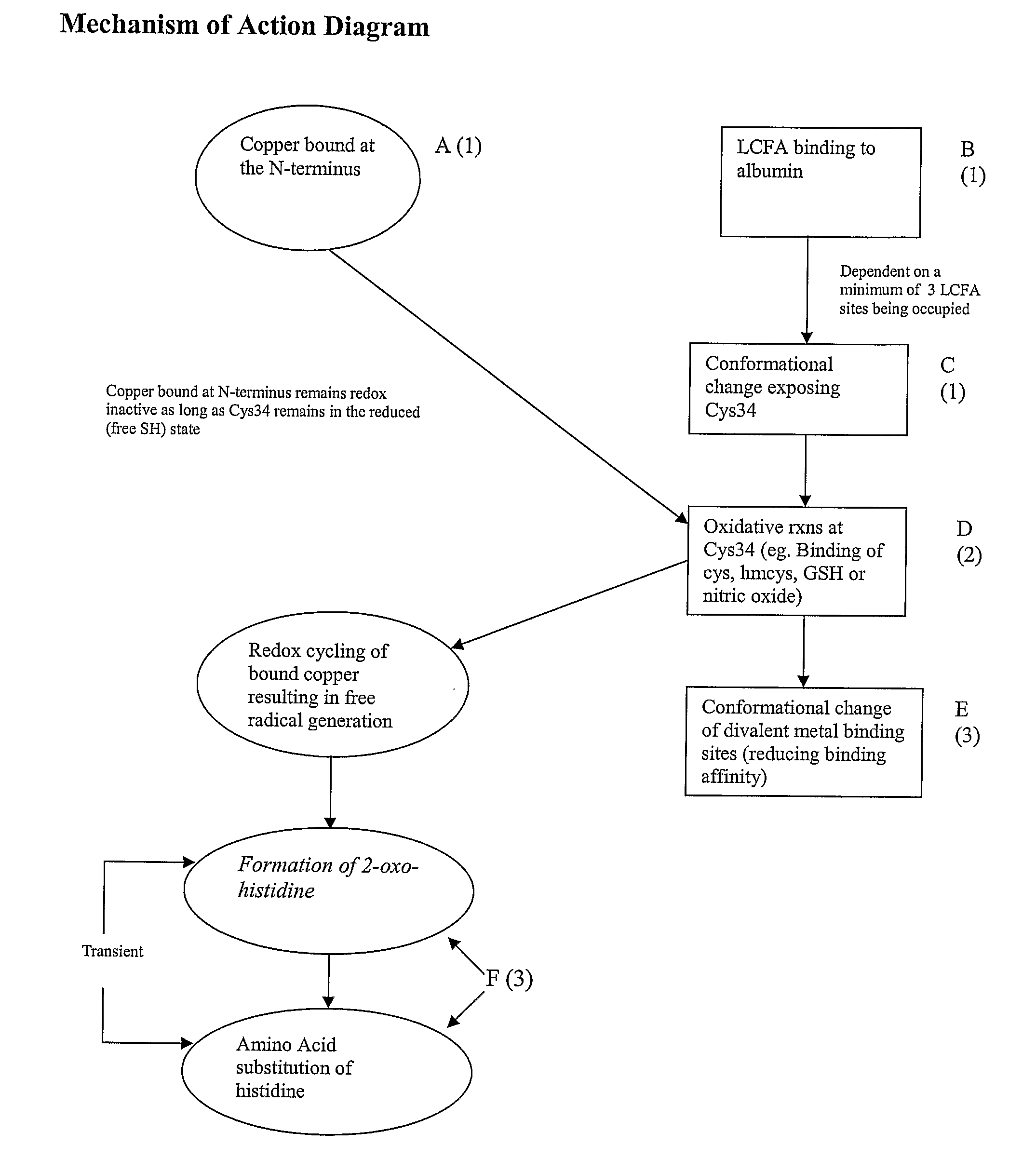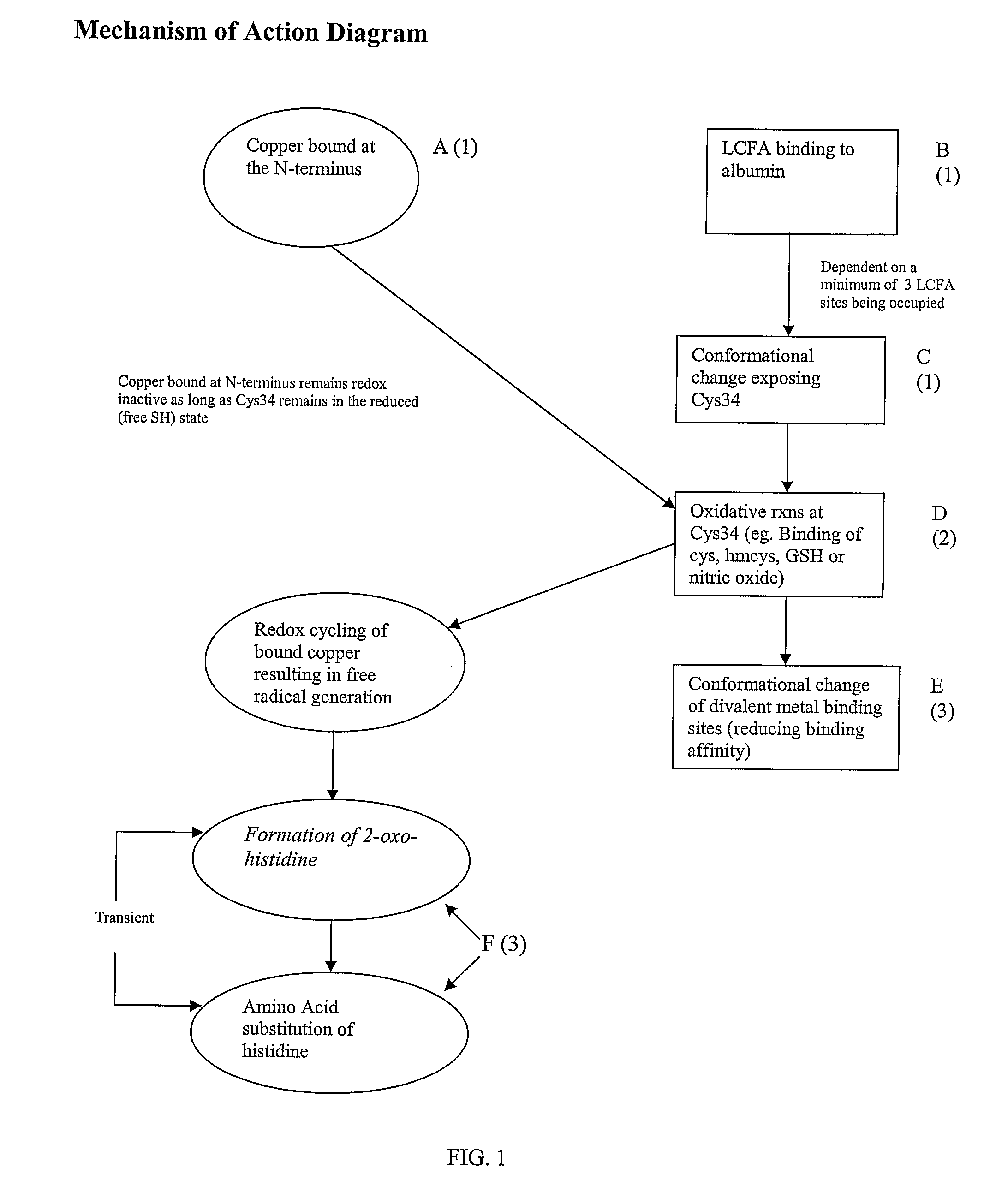Targets for Detection of Ischemia
a technology for detecting ischemia and ischemia cells, which is applied in the field of in vitro diagnostic devices, can solve the problems of poor accuracy, necrosis markers, cell death (necrosis), etc., and achieve the effect of monitoring the progress of the patient and improving the care of the patien
- Summary
- Abstract
- Description
- Claims
- Application Information
AI Technical Summary
Benefits of technology
Problems solved by technology
Method used
Image
Examples
example 1
Immunoassay Detection of IMA
[0049]This invention can utilize an immunoassay method of detection in which antibodies to each form of modified albumin can be made and used either as a cocktail or as individual antibodies. In this case an antibody would be generated to (a) the complex of Cu bound to the N-terminus of albumin; (b) the structure of one or more fatty acids bound to albumin; (c) the induced conformational change resulting in the exposure of the Cys34 site on albumin; (d) products of oxidative reactions at the Cys34 site, which include but are not limited to glutathione and homocysteine bound at Cys34; (e) the conformation change of albumin induced by sulfide containing molecules at the Cys34 site resulting in decreased binding of divalent metals at sites including but not limited to the N-terminus; (f) the altered divalent metal ion binding sites; (g) additional oxidative reactions taking place at the N-terminus as a result of free-radical production, which include but is ...
example 2
Detection of FFA Binding to Albumin by Spectroscopic Methods
[0060]Plasma or serum samples from a positive ischemia population have more fatty acid (FA) bound per albumin molecule, relative to that of samples from an apparently healthy, normal population. This observable event will be exploited to use as one arm in a detection scheme for the diagnosis of ischemia. FA binding to albumin can be measured qualitatively and / or quantitatively. One method is described below.
[0061]First, sample is moved through a column or over a plate or well, containing or lined with fluorescent-labeled fatty acid binding proteins (FABP). FABP may be purchased commercially or made specifically for this application. Free fatty acid (FFA) in the sample binds to the FABP and is quantified by fluorescence measurements using a modern / standard fluorometer, as understood by those familiar with the art.
[0062]The first step in the process, as described above, will yield (as eluent or supernatent) a FFA-free sample....
example 3
Detection of IMA, Conformational Change of Albumin Following FFA Binding to Albumin by Spectroscopic and Isoelectric Focusing Methods
[0065]Samples from a positive ischemia population have more FA bound per albumin molecule, relative to that of samples from an apparently healthy, normal population. Therefore, samples from the positive ischemia population will also show increased albumin conformation changes resulting from the FA being bound to albumin. This is another arm of a detection scheme to aid in the diagnosis of ischemia. Conformational changes to the albumin molecule, which result from FA binding, can be measured (qualitatively and / or quantitatively) by several methods. Two different methods are described below.
[0066]1. Determination by Isoelectric Focusing Methods[0067]Conformational changes to albumin, resulting from FFA binding to the protein, can be determined using isoelectric focusing methods (based on work reported from Gryzunov, Y. et al. (2003) Arch. Biochem. Biophy...
PUM
| Property | Measurement | Unit |
|---|---|---|
| concentration | aaaaa | aaaaa |
| conformational | aaaaa | aaaaa |
| fatty acid | aaaaa | aaaaa |
Abstract
Description
Claims
Application Information
 Login to View More
Login to View More - R&D
- Intellectual Property
- Life Sciences
- Materials
- Tech Scout
- Unparalleled Data Quality
- Higher Quality Content
- 60% Fewer Hallucinations
Browse by: Latest US Patents, China's latest patents, Technical Efficacy Thesaurus, Application Domain, Technology Topic, Popular Technical Reports.
© 2025 PatSnap. All rights reserved.Legal|Privacy policy|Modern Slavery Act Transparency Statement|Sitemap|About US| Contact US: help@patsnap.com



